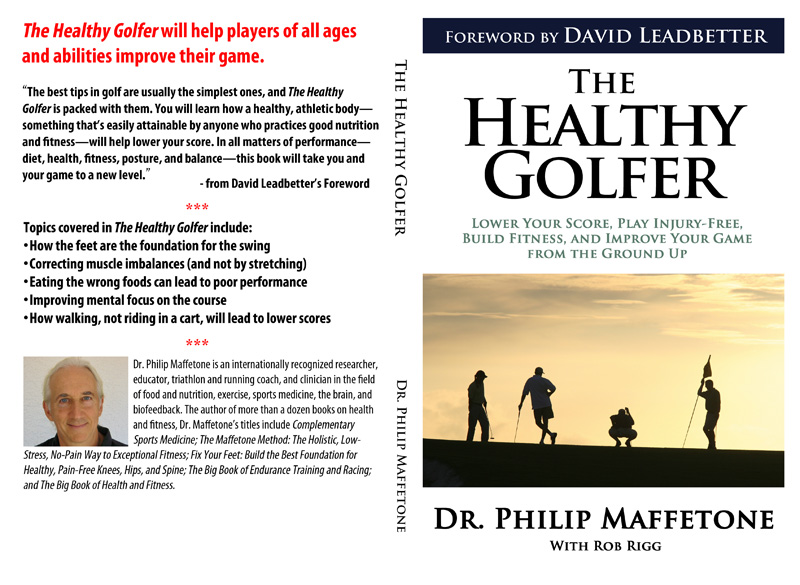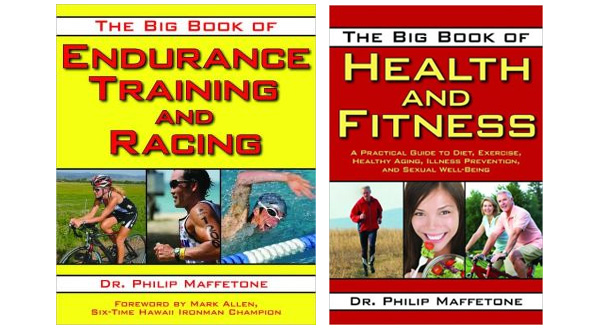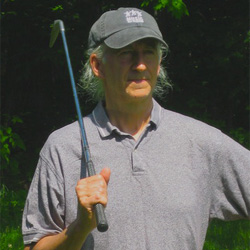Have you heard of barefoot golf? Less than 4 years ago, barefoot-style running shoes and minimalist shoes were unheard of. Now with companies like TRUE Linkswear, Foot Joy, VIVOBAREFOOT, and Skechers launching low- to zero-drop spikeless barefoot-style golf shoes, the time for barefoot golf is now.
I have the privilege of working with Dr. Phil Maffetone on his latest book, The Healthy Golfer, Lower your score, play injury-free, build fitness, and improve your game from the ground up. Phil is an advisor to the Natural Running Center and also a friend and coach/mentor. Phil has helped me with my track & field and heart rate monitor training so whatever I can do to help with his projects (including his music tour) it’s the least I can do to show what his teachings (especially MAF 180) has done for me.
The goal of The Healthy Golfer is to provide you with information that will help engage all of your senses on the course so you can enjoy the game as much as possible for your entire life. In fact, this book is intended to be a complement to swing-based golf instruction as it provides a platform to build a solid golf game from the ground up, starting with your feet and concluding with a discussion of brain function.
Dr. Maffetone is also the author of the bestselling books, The Big Book of Endurance Training and Racing, and The Big Book of Health and Fitness. And every athlete knows him as the father of heart rate monitor training.
I am not a golfer (only played about 3 times in my whole life) but as a runner, I have learnt a lot from this book about golf shoes (my wear tester Robert Yen review minimal shoes for golf on this site), muscle imbalance, brain functions, diet, and much more. And lessons learned here apply to any fitness activity, not just golf!
Here’s the Table of Contents but full details and excerpts on the book can be found on Phil’s The Healthy Golfer site: Barefoot Golf and Your Brain on Golf.
- Chapter 1: Feet First
- Chapter 2: Fix Your Feet—10 Barefoot Steps
- Chapter 3: Golf Shoes
- Chapter 4: Walk, Don’t Ride!
- Chapter 5: Warming Up, Flexibility, and the Risk of Stretching
- Chapter 6: Golf is a Game of Endurance
- Chapter 7: Muscle Imbalance and How to Correct It
- Chapter 8: Anatomy of a Golf Injury
- Chapter 9: Chronic Inflammation—Beyond Bone, Muscle, and Joint Dysfunction
- Chapter 10: Eat Well, Play Well—How a Healthy Diet Can Improve Your Game
- Chapter 11: Water Hazard—Too Much or Too Little Can Affect Your Game
- Chapter 12: Finding The Right Therapist to Fix Your Injury
- Chapter 13: Your Brain on Golf
- Chapter 14: Stress and Golf Don’t Go Together
- Chapter 15: Strength Training for Bones and Muscles
- Chapter 16: The Healthy Side of Sun
- Conclusion: Becoming a Healthy Golfer
- Appendix A: The 180 Heart-Rate Formula
- Appendix B: Body Supports—Inserts, Orthotics, Taping, and Braces
- Appendix C: The Best Energy Bars and Shakes
For a limited time only, the Amazon Kindle version of The Healthy Golfer is available for FREE download Saturday June 8 until Wednesday June 12. It is also free (next 90 days) if you are an Amazon Prime member. So grab your copy in the next few days – it will be good weekend reading!
The Healthy Golfer is now available in both print edition and Amazon Kindle format at Amazon.com
Here’s a sample chapter (reprinted with permission from Dr. Maffetone), Your Brain on Golf.
Your Brain on Golf
An excerpt from “The Healthy Golfer: Lower your score, play injury-free, build fitness, and improve your game from the ground up” by Dr. Philip Maffetone
Perhaps one of the best lessons about golf is related to the brain. This advice comes from Green Bay Packers’ legendary coach Vince Lombardi, who said, “Practice does not make perfect. Only perfect practice makes perfect.” This certainly applies to golf.
Golf was Lombardi’s other favorite game next to football. In the September 1992 issue of Golf Journal, Lombardi drew analogies between both sports. “Those who like games get more out of golf than any other. Golf is more than a game. I liken it to football because it makes many of the same demands football does. For example, it takes courage–it takes a lot of guts to play golf. And it takes a lot of stamina. It also takes coordinated efficiency–and you must be dedicated to win.”
Scientists have shown there is a direct relationship between practice and scores—something most golfers already know. Specifically, hitting the accumulation of 10,000 hours of practice should help golfers achieve near scratch scores. For many amateur players, the same researchers show that practice times of 5,000 to 10,000 hours can bring handicaps into the low double-digit range. But this means quality practice, not hours of beating balls on the range. Hours of practicing putting in your living room while watching TV may help improve your stroke, but that does not constitute perfect practice either. To practice efficiently in golf you must be focused on every shot, whether on the practice tee, putting green, or out on the course. Otherwise, you are just beating balls or rolling putts for amusement. You may also choose to partner with a teaching professional to reach the next level of your game. The key at the end of the day is to create a repeatable swing that works on the range, on the course and in the heat of the moment during a match or tournament.
“Perfect Practice”
How does perfect practice make perfect golf? By training the brain, which controls every movement, each thought, include-ing muscle memory, before during and following each shot.
As John Milton, Ph.D. and colleagues from the Brain Research Imaging Center at the University of Chicago, Illinois state, you must reach “a level of maximal performance that far exceeds that of non-experts and a degree of privileged focus on motor performance that excludes intrusions.” Their study demonstrated that brain activation of expert golfers during their pre-shot routine is radically different from that of novices. The difference is practice.
Of course, research statistics do not usually apply to any one individual’s game, as some people with more innate hand-eye coordination excel quicker than others. But the importance of many practice hours is still real, as evidenced by the commitment it takes to become a low handicapper. The bottom line is: perfect practice makes perfect.
Golf is a sensory-motor activity, one highly influenced by repetitive practice sessions that are of high quality. This means you sense the ground, club and your surroundings, including the target; and the brain analyzes this information. Based on where the ball should go, the brain determines the best approach to accomplish it, sending information from the brain’s motor areas, which tells your muscles, ligaments, joints and other bodily areas what to do. All this happens in a very short amount of time.
High-quality practice hours accomplish something in the brain that is powerful for both good and bad reasons. First the bad: Imperfect practice makes for bad habits. Too many people learn improperly from a friend or parent, watching others on the driving range, or develop flaws in their swing all on their own. If any sensory or motor part of the equation is not correct then you will learn a bad habit.
It is better not to practice than to practice poorly. Even if you have never played golf or taken a lesson, the brain will have a fairly good idea about how to hit that little white ball in the direction of the hole—the brain has a natural sense of what needs to be done.
The more you play, good or bad, the more the brain learns. It is called plasticity, a learning process whereby new connections between neurons (brain cells) are made leading to a better functioning brain. It really means you actually can teach old dogs new tricks, now matter how young or old you are. But these should be good, positive lessons for the brain to learn—and replicated over time
The bad habits are too often what your brain remembers, typically because you have practiced that bad swing more than a good swing. But the brain is forgiving—start all over with good habits, put in your time, and your practice sessions will keep progressing. You will literally override the bad habits with good ones. One of the most important aspects of the process of perfect practice is focus.
Learning to Focus
I remember the first time holding one of my grandfather’s golf clubs when I was in high school. I thought about my feet, knees, hands, grip, shoulders, and wrists. What I lacked was focus on just swinging the club and trying to hit the small white ball on the ground. My brain was seriously overwhelmed with all of the stimuli and the complexity of executing a swing.
One of the important results of being successful in practice is that it trains the brain to focus on only the most important issues that result in a great swing. In the study by Milton and colleagues noted earlier, the researchers showed that during the setup of a shot for a novice golfer, a variety of brain areas were active, including those not necessary for a successful swing. But with the expert players, brain activity was limited to only the areas important for making a great shot
The novice concentrates on how he or she is going to move each body part, thinking about past lessons or maybe an instructional photo in a golf magazine, and incorporates significantly more of the memory and emotion centers of the brain in the process. The novice is really in an active phase of learning, with a lot of thinking about voluntary motor control.
The expert player, however, will direct attention to overall motor planning as it pertains to distance and lift, and not each body part. Emotion and memory are much less active because the swing has already been learned through many hours of practice. Attention is directed externally, using the eyes and visual areas of the brain to “see” the expected, or imagined, flight of the ball. The attention is on the goal—what happens after the swing.
The novice will focus internally on the body to execute what he or she thinks is the proper movement, consciously thinking about grip, shoulders, hips, hands, arms and other specific body parts involved in the swing. While this is a part of progressing through perfect practice, it will result in too much thinking on the course—a golf swing is not the sum of many mechanical activities, it is one athletic movement. As the great Bobby Jones once said, “You swing your best when you have the fewest things to think about.
How can you program your brain to accomplish all this? By practice. Once you can address the ball without thinking about all this clutter or “noise,” you will become a better golfer. The process involves being able to perform a delicate activity without consciously thinking about it, which develops into good experience followed by perfect practice.
Most people already perform this way in other areas of life. Like with those who know how to type or play the piano. Finding the correct key with each finger is usually done without any detailed thinking or conscious thought. The same is true with golf—the accumulation of all those hours of practice will allow you to hit the ball without all the internal over-evaluation.
Of course, there is much more. Volumes have been written about the brain and how it functions best in relation to eye-hand coordination, precision, motor intentions, sensory awareness of other features important for better golf. But you do not need to study these complex physiological factors. Finding an instructor who matches your personality and level of play, reading books on great golf or watching videos can all be helpful as part of your quest for perfect practice.
In addition to perfect practice there is something even more important—a healthy brain.
Building a Healthy Brain
You can improve brain function at any age. A healthy brain will help you play better golf, but that is not all. Healthy brains do not get sick, which will help you avoid the many preventable diseases common during aging.
Below are four key aspects of building a better brain.
1. Having a Healthy Body. As discussed previously, a healthy body comes from eating nutritious food, hydrating properly, aerobic exercise and enjoying activities that you find stimulating.
2. The Comfortable Brain. When the body is physically and chemically better balanced, the brain is literally more comfortable, not rushing to put out “fires,” so to speak. Imagine you are on the tenth hole and all you can think of is the stressful phone call you had two hours earlier, the pain in your knee, and an important meeting tomorrow. Your brain is not focusing on your game, and it is uncomfortable.
3. Brain Recovery. Just like the rest of the body, the brain requires recovery every day. Most of this occurs with a good night’s sleep. Adults need at least seven hours of uninterrupted sleep each night. While some people fall asleep and stay that way easily, many others do not.
A common sleep problem is waking up in the middle of the night, typically due to an elevation of stress hormones being out of sync. Many men past the age of 40 will get up to urinate after awakening, and erroneously believe they woke for that. Stress hormones should elevate around sunrise, but in many stress conditions, they increase during the middle of the night, often resulting in a difficult time getting back to sleep—it is as if you are experiencing jet lag. This problem is usually due to an accumulation of physical, chemical and mental stress.
Another common pattern of sleep difficulty is being unable to fall asleep. This may be associated with too much physical tension, another type of stress. While poor sleep is a common and often complex problem and sometimes with multiple causes, below are some important tips that can help many improve sleep quality:
- Create the best sleeping environment by eliminating noises, electronics and lights in the bedroom.
- Have a healthy, comfortable bed and natural bedding.
- Keep the room a bit cooler and assure enough humidity in the air in dry environments.
- To better prepare for a good night, take a warm bath or shower before bed.
- Avoid pre-sleep bad habits: TV can negatively affect the brain, drinking alcohol within at least two hours before bed can disturb sleep, likewise with caffeinated drinks. And of course, avoid processed carbohydrates. And if you want to read late in the evening, do it on a couch or chair in the living room or study instead of in bed.
- One way to find out how much sleep you need is to avoid using an alarm clock. Go to bed when you feel tired and get out of bed when you wake up.
- Of course, a healthy body and brain is the best way to sleep well. In addition to stress, injury, chronic illness and other unhealthy conditions can often impair sleep.
4. Healthy Stimulation for a Better Brain. In addition to practicing your swing, developing better overall health, and raising your fitness level, stimulating the brain with certain neuro-activities can make it work better. That is because, no matter your age, you can grow the brain through plasticity.
The most important part of the body that can dramatically improve your game is also the most neglected and least discussed—the brain. This relatively small body part controls everything. By making it better you will also reap many health benefits.
http://philmaffetone.com/healthygolfer.cfm
*Product provided by Dr. Maffetone. CMP.LY/1 Review
If you have a product you’d like reviewed, contact me at info@weartested.org





